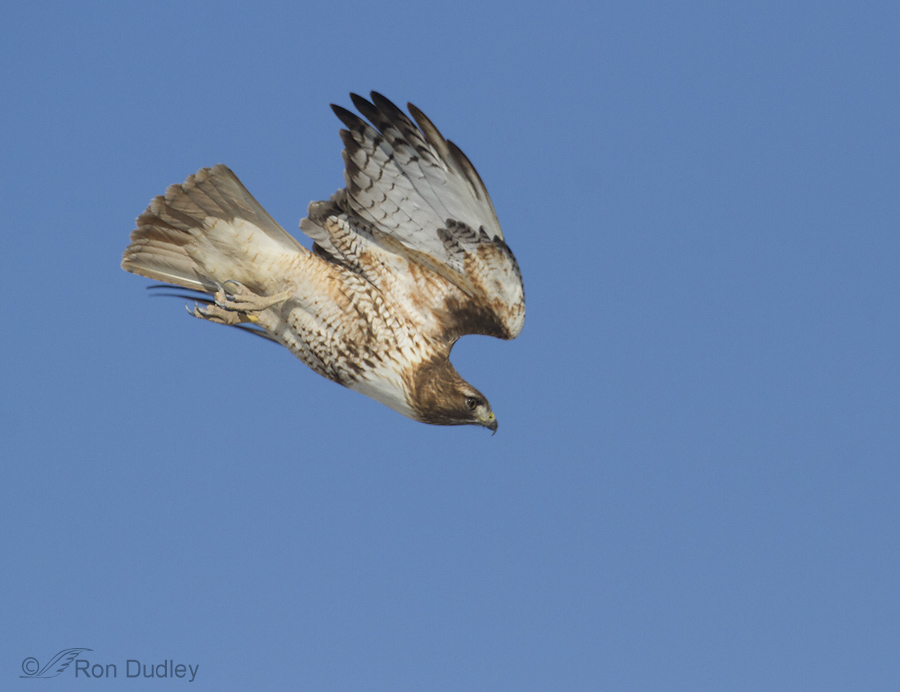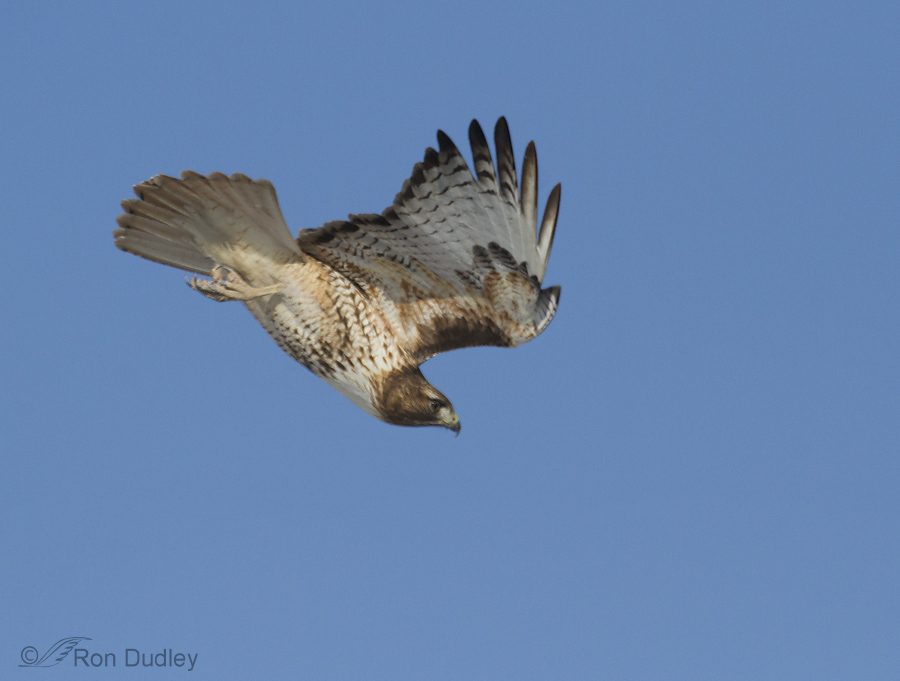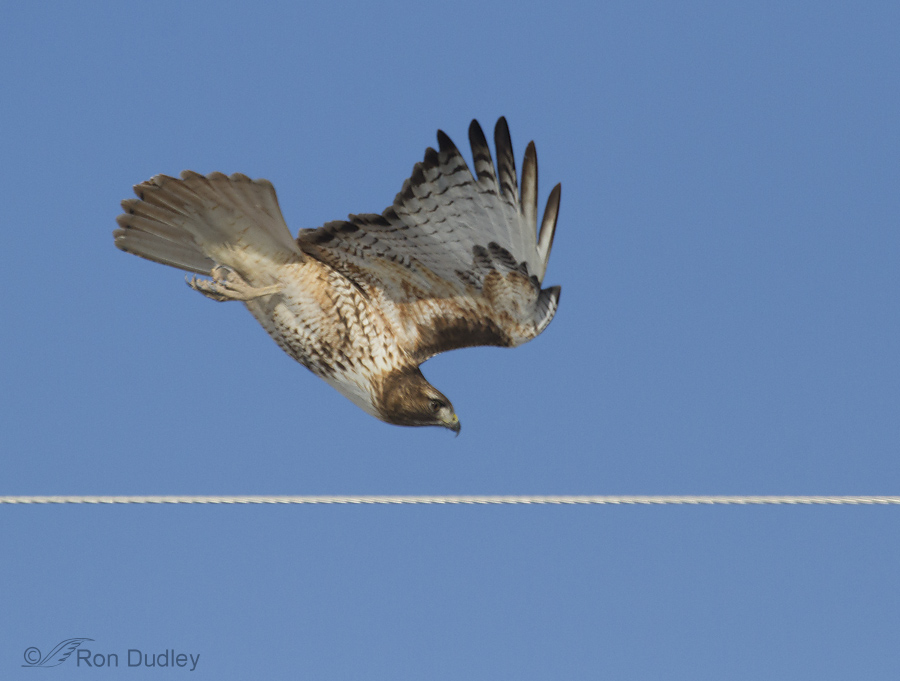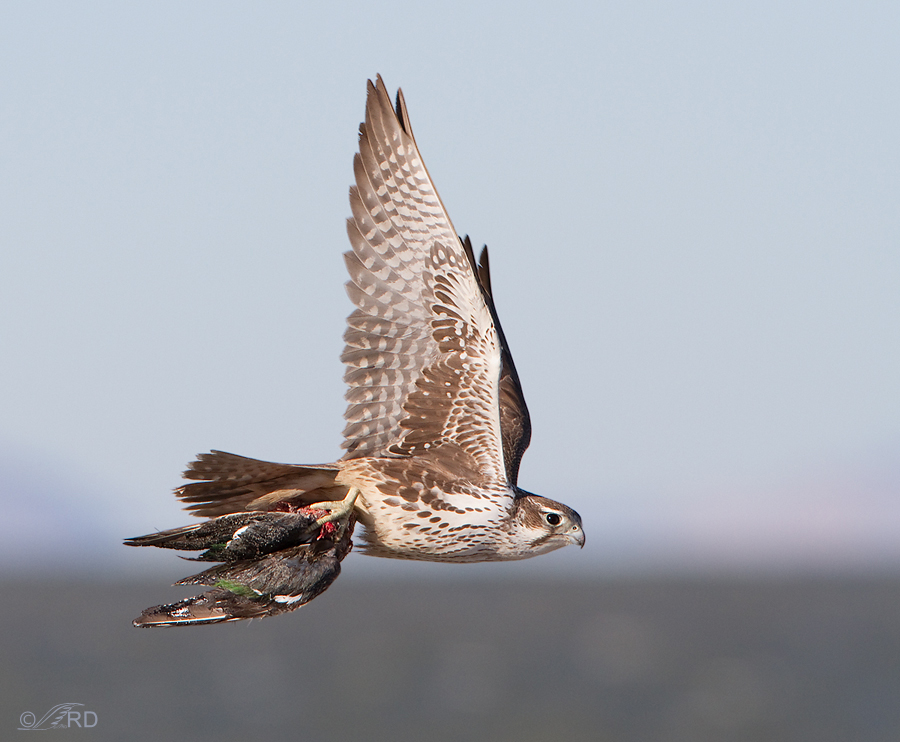When a raptor dives on prey from an elevated perch one has the opportunity for fairly dramatic flight shots because of the angle of attack and wing position.
1/2000, f/8, ISO 500, Canon 7D, 100-400 @ 400mm, not baited, set up or called in
Recently I’ve spent several days with this Red-tailed Hawk as it hunted voles from relatively short power poles in Utah County. Usually when it spotted prey it was far enough away that the bird took off at a normal angle but occasionally the vole would be relatively close to the perch so the bird would launch at a steep angle. I think the angle and wing position of such shots adds to the drama.
But with a featureless blue sky as background it begs the question – “was this the true angle of the bird?”. There are no visual cues in the background (such as a horizon line) as to what is “level” and when one shoots hand-held or from a vehicle window it’s very easy, even typical, for the camera to be seriously off level as you follow the bird. In cases like this it may even be tempting for the ethics-challenged photographer to artificially exaggerate the angle during processing by using the “rotate” tool.
1/2000, f/8, ISO 500, Canon 7D, 100-400 @ 400mm, wire removed, not baited, set up or called in
This is the next frame in the sequence and even though the hawk isn’t as sharp as I’d like I’ll use the image to make my point. It can be surprising where the photographer can find cues as to what angle is truly level (or at least close to it) – either in the image in question or in previous or subsequent images. There have been times when I’ve gone to other images in the sequence for the cues I needed – horizon lines, vertical elements like vegetation or a whole host of other possibilities.
In this case my visual cue was one of those blasted power lines that I’ve complained about so often.
1/2000, f/8, ISO 500, Canon 7D, 100-400 @ 400mm, not baited, set up or called in
This is the same image as the one above without the wire removed. I made the assumption that the wire was fairly close to level so I rotated the image to level the wire before I removed it. I’m sure the wire was at a bit of an angle as it came off the pole but still I’m confident that that this was reasonably close to the true angle of the bird as it came off the pole.
Rotation can be tricky. When I posted this image of a Prairie Falcon carrying a Northern Shoveler to an online critique forum, one experienced bird photographer dinged me because she said the falcon was tipped too far forward in flight so the image needed counter-clockwise rotation. She failed to notice the horizon line (Great Salt Lake/sky on a blustery morning – the out of focus blobs on the water are whitecaps) and to take into account that when the falcon is hauling a load like this it would affect the angle of attack.
For me, images that aren’t properly rotated to level (when there are visual cues to level) are seriously distracting. This is an especially common problem for birds on/in water when there are reflections involved – possible grist for another post in the future…
Ron






Just sensational ahots Ron! Thanks so much for sharing them!
Charlotte
Wonderful dive shot…so glad you removed the ugly wire. That bird bomber has laser focus!!! Seems to this VERY amateur photographer that the edges, and the thin, white border of the picture, tells us the angle of the bird…as does the misty horizon line…I don’t feel the need for anything more.
It seems to me that this redtail’s neck and head are fairly horizontal. I don’t know if that’s always the case.
These are great shots. Funny, but I looked at the Hawk and Falcon without the vaguest concern for the angle. Anyone observing a bird of prey with prey know that there will be an angle. So what? I was more interested in that you got such a wonderful shot of the Falcon and his prey and the angle simply shows that the prey is heavy.
I would agree with removing the wire from the Red-tail stoop photograph, I’d do the same thing. The image of the wire gets in the way.
Ron, These are fantastic shots, whether the rotation is perfect or not. I have myself often noticed that I almost never take level shots — waterfowl is indeed especially difficult in that regard!
I seldom take them level either, Pierre – sometimes even when I’m shooting from my tripod and I think it’s level.
Ron, whoever criticized that Prairie Falcon photo was simply jealous…
Could be, Jerry – though usually this person seems to try to be pretty honest in her critique.
Oh, I misinterpreted why you mentioned the critique, my bad.